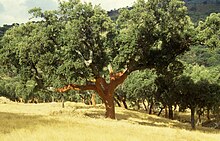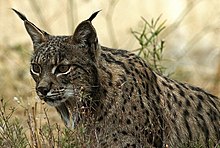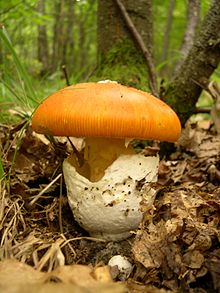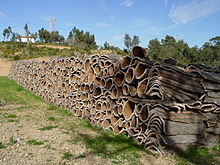Quercus suber
In the Mediterranean basin the tree is an ancient species with fossil remnants dating back to the Tertiary period.Since cork for sealing bottles is increasingly being displaced by other materials, these forests are at risk as part of the cultural landscape and as a result animal species such as the Iberian lynx and imperial eagles are threatened with extinction.[5] The cork oak grows as an evergreen tree, reaching an average height of 10 to 15 metres (33 to 49 feet) or in rare cases up to 25 m and a trunk diameter (DBH) of 50 to 100 centimetres (20 to 39 inches).It forms a dense and asymmetrical crown that starts at a height of 2–3 m (6+1⁄2–10 ft) and spreads widely in free-standing trees.The cambium of the smooth bark of young trees forms a cork layer very early on, which can be 3 to 5 cm (1+1⁄4 to 2 in) thick.The light and spongy cork fabric shows vertical cracks and is white on the outside and red to red-brown on the inside.[8] The cork oak develops a taproot that reaches a depth of 1 to 2 m (3+1⁄4 to 6+1⁄2 ft) and from which several meters long, horizontally running side roots extend.At the base of the petiole are two narrow, lanceolate, 5 mm (1⁄4 in) long and bright red stipules that fall off in the first year.They are bright red at the beginning and stand upright, older catkins are yellow and pendulous, 4 to 7 cm (1+1⁄2 to 2+3⁄4 in) long and have a whitish hairy axis.[10][12] There are natural populations of the nominate form at altitudes between 150 and 300 m (490 and 980 ft) above sea level, the subspecies occidentalis is found along the Atlantic coast.[1] Outside of its natural range, the cork oak is cultivated in the Crimea, the Caucasus, India and the Southwestern United States.[17] The most virulent cork oak pathogen may be Diplodia corticola, a sac fungus which causes sap-bleeding sunken canker wounds in the wood, withering of the leaves, and lesions on the acorns.[17] The common water mould Phytophthora cinnamomi grows in the roots of the tree and has been known to devastate cork oak woodlands.[17] Several species of butterflies damage the cork oak, the most important being the spongy moth (Lymantria dispar).The species lays its eggs in the bark of the branches and trunks, and the caterpillars that hatch in spring are distributed in the crown and eat them bare.[18] Unfavorable climatic conditions and fungal attack are made responsible for the weakening of trees and for crown damage.Such fungal parasites of weakness are Botryosphaeria stevensii, Biscogniauxia mediterranea, Endothiella gyrosa and representatives of the mold genus Fusarium.[23] Cork oaks cannot legally be cut down in Portugal, except for forest management felling of old, unproductive trees, and, even in those cases, farmers need special permission from the Ministry of Agriculture.The process mandates specialized training due to the skill required to harvest bark without inflicting too much damage to the tree.[citation needed] Cork oaks are sometimes planted as individual trees, providing a minor income to their owners.[32] In 2007, a 2 euro commemorative coin with the motif of a cork oak was issued in Portugal in memory of the Portuguese Presidency of the European Union.












Conservation statusLeast ConcernIUCN 3.1Scientific classificationPlantaeTracheophytesAngiospermsEudicotsRosidsFagalesFagaceaeQuercusQuercus subg. CerrisQuercus sect. CerrisBinomial nameSynonymsevergreencricket ballsAfricaMediterranean basinfossilTertiary periodsoil qualitydesertificationwoodlandsIberian lynximperial eaglescambiumKöhler's Medicinal Plantsleavesmonoeciousflower envelopecatkinsstamensfruit clusterscupulepericarpCerrisValonia oakTurkey oakQuercus × crenataMacedonian oakholm oakhybridspedunculate oakspecific epithetAtlanticTyrrhenian SeaApuliaAdriatic SeaDalmatian coastSardiniaMoroccoHigh AtlasCrimeaCaucasusSouthwestern United StatesCentral Europecalcareousacidity of the soilpyrophytesavannaIberian PeninsulaMediterranean woodlands and forestsecoregionQuercus ilexQuercus rotundifoliaQuercus fagineaQuercus pyrenaicaQuercus canariensisPinus pinasterPinus pineaArbutus unedoOlea europaeaCastanea sativaQuercus cocciferaQuercus lusitanicaRhamnus alaternusPhillyreaMyrtus communisErica scopariaSmilax asperaCistus monspeliensisforest firesmaritime pineMediterranean biomemycorrhizalsymbiosisfungusCaesar's mushroomDeath capPanther capGilbert's limbed lepidellaLeaf spotApiognomonia errabundapowdery mildewcankersDiplodia corticolasac fungusoak pinhole borerPhytophthora cinnamomispongy mothBacillus thuringiensisgreen oak tortrixlackey mothbrown-tail mothjewel beetlegreat capricorn beetleBotryosphaeria stevensiiEndothiella gyrosaFusariumCork (material)montadosdehesascellulosesuberinphellogenNorth Africapruningstoppersspace industrycomposite materialstanninIberian hamforest managementtonnes